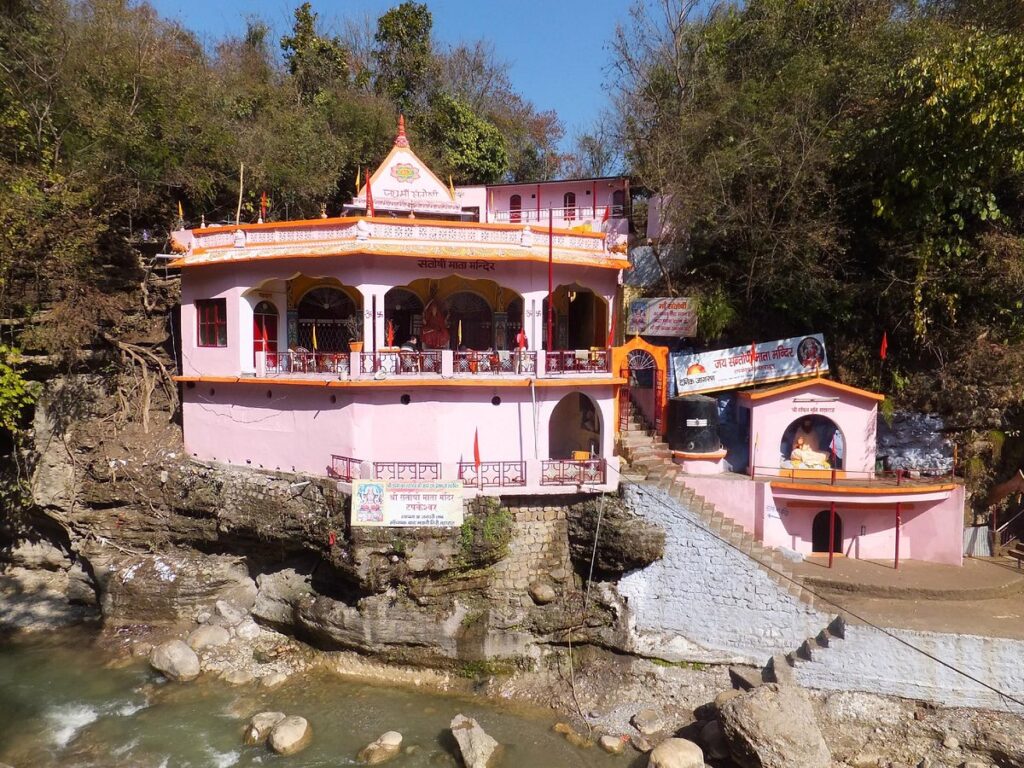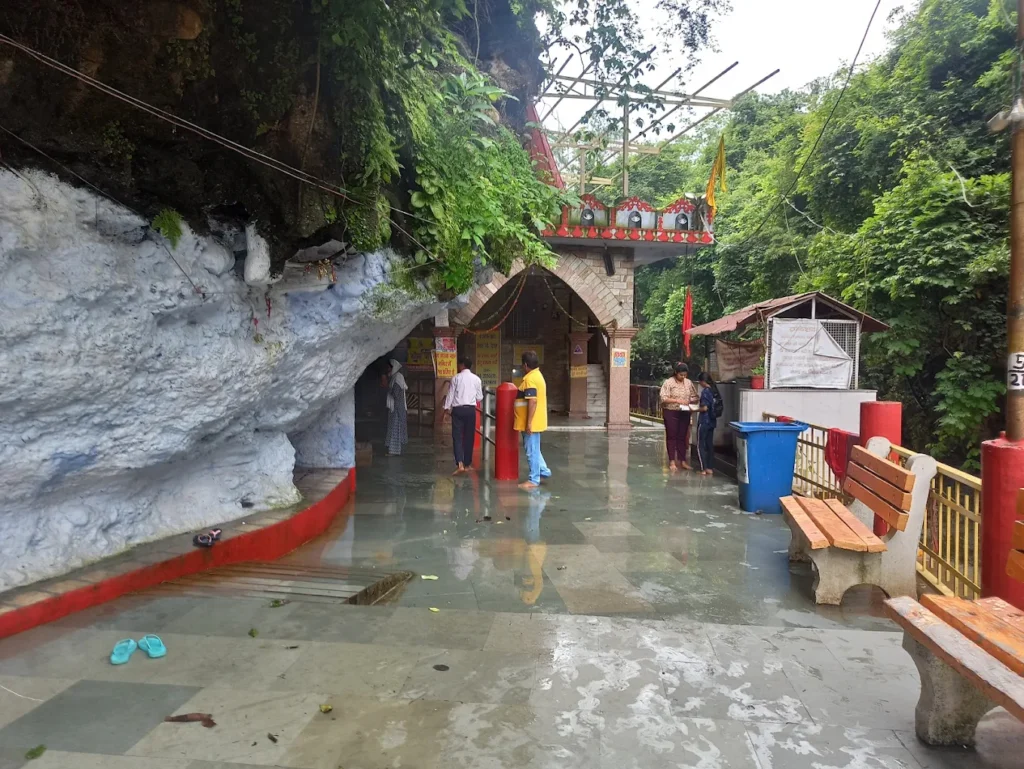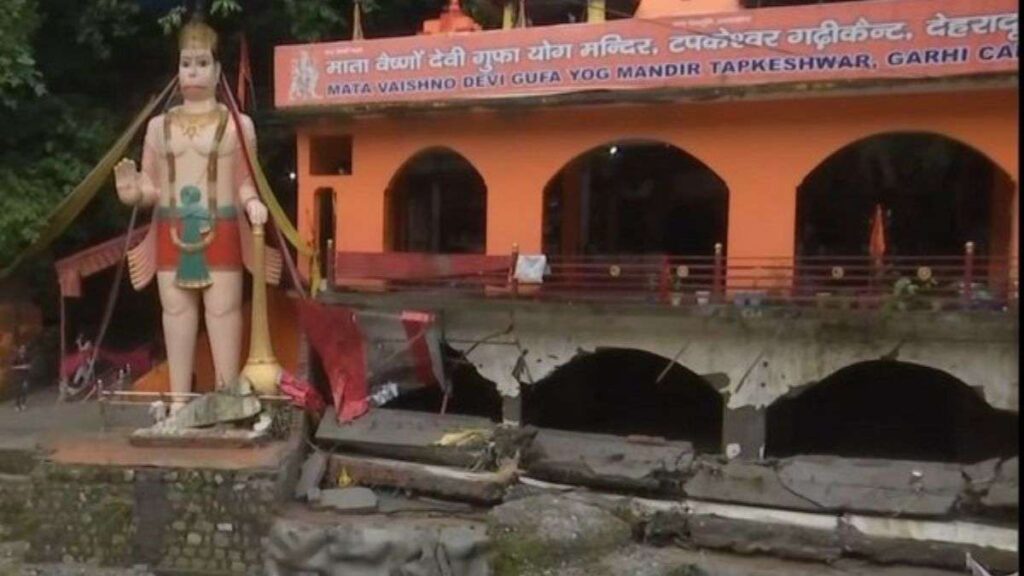Dehradun is known for its lush hills, colonial charm, and busy bazaars, but just a short drive from the city lies a place where silence speaks louder than words—the Tapkeshwar Temple. Nestled along the banks of a seasonal river and built inside a natural cave, this temple feels like you’ve stepped back in time.
The first time I visited, I didn’t expect much. A local friend simply said, “You must see Tapkeshwar Temple—it’s different from the usual temples.” And he was right. Unlike big, crowded shrines, this temple has an old-world simplicity. The sound of dripping water, echoing chants, and the cool cave air made me pause and just breathe.

The Story Behind Tapkeshwar Temple
A Cave That Breathes History
Long before it became a temple, the cave was known as Drona Cave. This connects directly to the epic Mahabharata, one of the greatest Sanskrit epics of India. According to tradition, Guru Dronacharya, the legendary teacher of both the Kauravas and Pandavas, is believed to have meditated here. Some locals even say that the cave provided him with solitude and inspiration during his years of spiritual practice.
Think about that for a moment—this wasn’t just a cave of stone, but a silent witness to the beginnings of stories that shaped India’s cultural imagination. Every time you walk into the dimly lit passage, you’re stepping into a space where myth and reality blend seamlessly.
Why It’s Called “Tapkeshwar”
The name itself has a story to tell. Inside the cave rests a natural Shivling—an abstract representation of Lord Shiva. What makes it unique is that water droplets constantly drip from the ceiling onto the Shivling, as if nature itself is performing an endless abhishek (ritual bathing).
This phenomenon gave the temple its name:
- “Tapak” means “drip” or “drop.”
- “Ishwar” means “God.”
Put together, Tapkeshwar means “The God who receives water drops.”
For devotees, these drops aren’t just water—they are sacred offerings, believed to purify sins and bring peace of mind. It’s as if Shiva, the eternal yogi, designed his own temple, where time and nature continue the rituals without human interruption.

The Mahabharata Connection: Dronacharya and Ashwatthama
One of the most moving legends tied to this temple involves Dronacharya’s son, Ashwatthama. The story goes like this:
Dronacharya and his wife, Kripi, had a son named Ashwatthama. As a child, Ashwatthama once saw other children drinking milk and felt deeply sad because his family was too poor to afford it. Moved by his son’s longing, Dronacharya prayed intensely to Lord Shiva for help.
Pleased with his devotion, Shiva blessed Ashwatthama with milk—miraculously provided by nature in this very cave. Some say the dripping water once carried the essence of milk, nourishing the boy. Over time, that divine act turned into a legend, and the cave itself became a symbol of Shiva’s compassion toward his devotees.
Even today, many locals narrate this story to children when they visit the temple. For them, Tapkeshwar isn’t just a place of worship—it’s a reminder that sincere prayers never go unanswered.
A Temple Without Walls
Unlike grand temples with towering spires and golden domes, Tapkeshwar Temple feels raw and natural. The cave walls are rough, damp, and alive with the sound of dripping water. And that’s the beauty of its story—it never needed human-made grandeur because nature itself became the architect.
Many historians believe that this was originally a natural cave shrine, used by wandering ascetics and sages long before it became a structured temple. Over time, as more and more devotees came here after hearing the legends, it evolved into the sacred site we see today.

Living Traditions: The Dripping Water as Eternal Puja
Every religion has rituals to show devotion. In Hinduism, bathing the deity (abhishek) with milk, water, or honey is a deeply symbolic act. At Tapkeshwar, nature does this ritual endlessly. For devotees, this is proof of Shiva’s presence in the cave.
They believe that by touching this water, or by offering their own prayers here, their burdens are washed away. I’ve seen pilgrims carefully collect drops of water in small bottles to take back home, treating it as holy as Ganga jal (water from the Ganges).
How Locals Keep the Story Alive
What makes the story of Tapkeshwar fascinating is that it isn’t just a tale frozen in books—it lives in everyday life.
- Festivals – During Mahashivratri, thousands of devotees pour into the cave. Priests retell the legends, and the whole place glows with diyas. For locals, it’s not just a festival, but a reenactment of the cave’s history.
- Folk Tales – Many elders in Dehradun still narrate Ashwatthama’s milk story to kids, keeping the myth alive for the next generation.
- Faith Tourism – Guides and priests often remind visitors about the cave’s connection to Dronacharya, making it a bridge between mythology and modern travel.
Beyond Myth: A Symbol of Simplicity
Whether you believe in the legends or not, the story of Tapkeshwar Temple carries a deeper lesson. It shows that faith doesn’t need luxury or spectacle. Sometimes, the humblest cave with a few drops of water can carry more spiritual weight than the grandest temple.
I think that’s why the temple resonates with so many. You don’t need to be a religious scholar or a saint to feel the cave’s energy—you just need to sit quietly, listen to the drops, and let the story sink in.

Why the Temple Feels So Special
Temples often get crowded, noisy, and even overwhelming, but Tapkeshwar has a very different vibe. Here’s what stood out to me:
- The Cave Atmosphere – The temple is literally carved into a limestone cave. When you step inside, the temperature drops, the air feels damp, and you can hear the steady sound of dripping water. It almost feels like nature itself is worshipping.
- The River Beside the Temple – A small stream flows outside, where visitors and families sit, dip their feet, or just watch kids play. During summers, this place becomes a mini-picnic spot, yet it retains its calm spiritual energy.
- Simple, Unpretentious Rituals – Unlike larger temples where rituals can feel commercial, here everything is intimate. Priests perform puja in a straightforward manner, and you never feel rushed.
- The Blend of Faith and Relaxation – You’ll see pilgrims offering milk to the Shivling, but also groups of students or travelers just sitting quietly near the river. That mix makes Tapkeshwar feel both sacred and welcoming.
Best Time to Visit Tapkeshwar Temple
Spring (March – April): A Pleasant Beginning
Spring in Dehradun feels like nature is stretching its arms after winter. The weather is mild, with temperatures ranging between 15°C and 25°C, making it ideal for outdoor exploration.
Visiting Tapkeshwar during these months is especially soothing. The walk to the cave is comfortable, the stream outside flows gently, and the flowers around the area add color to the journey. You can sit by the banks of the seasonal river and watch locals dipping their feet in cool water.
- Why visit now? Perfect weather, moderate crowds, and a chance to enjoy the temple in peace before the heavy tourist season begins.
- Travel tip: Carry a light shawl or jacket for evenings, as it can still get a little chilly inside the cave.
Summer (May – June): Warm but Manageable
Summers in Dehradun can get warm, with daytime temperatures rising up to 35°C. Yet, the good news is that inside the cave temple, it stays pleasantly cool. The dripping water and shaded surroundings provide natural air-conditioning.
This is also the time when schools are on vacation, so you’ll find families, especially with children, visiting the temple. The vibe is lively, though it can get a bit crowded during weekends.
- Why visit now? If you’re traveling with family, this is a good season. The temple offers a cool escape from the city’s heat.
- Travel tip: Visit early in the morning or late in the evening to avoid the midday sun and big crowds.
Monsoon (July – September): Not Recommended
This is the one season I’d strongly advise you to avoid. The monsoon in Dehradun can be heavy, with rainfall making the paths around Tapkeshwar Temple muddy and slippery. The cave itself becomes tricky to access, and the stream outside often swells with rainwater.
For safety reasons, this isn’t the right time to visit. Landslides in nearby hilly areas can also disrupt travel plans, and the otherwise calming atmosphere turns chaotic with excessive water flow.
- Why avoid now? Risky travel conditions, waterlogging, slippery paths, and reduced safety inside the cave.
- Travel tip: If you’re in Dehradun during monsoon, it’s better to explore indoor attractions like museums or cafes and plan your Tapkeshwar visit for later.
Autumn (October – November): The Golden Window
If there’s one season I’d call the best time to visit Tapkeshwar Temple, it’s autumn. The rains have washed the city clean, the skies are clear, and the temperature settles around a comfortable 12°C to 28°C.
During these months, the temple looks especially beautiful. The greenery around the cave is fresh, the riverbanks are lively, and the cool air makes sitting inside the temple cave even more meditative. This is also the time when you’ll find many travelers coming for photography, thanks to the crisp light and scenic surroundings.
- Why visit now? Best weather, fresh surroundings, and ideal for spiritual seekers as well as casual travelers.
- Travel tip: October also coincides with many Hindu festivals. If you visit around Mahashivratri or Diwali season, expect the temple to be buzzing with cultural energy.
Winter (December – February): Quiet and Spiritual
Winter in Dehradun is chilly, with temperatures dropping as low as 3°C at night. Daytime remains manageable, hovering between 10°C and 20°C. Visiting Tapkeshwar Temple during this season feels different—it’s quieter, calmer, and more spiritual.
There are fewer tourists, so you can spend as much time as you want in the cave without any rush. The water drops feel colder, but somehow that adds to the experience, reminding you of Shiva’s connection with austerity and simplicity.
- Why visit now? Perfect for those seeking solitude, meditation, or a spiritual atmosphere without distraction.
- Travel tip: Dress warmly, especially if you plan to spend time by the river. Carry a thermos with hot tea—it feels heavenly after a cold darshan.
My Personal Recommendation
Having experienced Dehradun in multiple seasons, I’d say the sweet spot to visit Tapkeshwar Temple is between October and April. The weather is kind, the temple surroundings are easy to explore, and the cave’s natural beauty shines during these months.
On the other hand, avoid July to September at all costs. Even locals advise against going during monsoon. It’s simply not worth the risk—better to wait for clear skies and safe paths than rush into an unsafe trip.
Getting There
The temple is only about 6 kilometers from Dehradun city center, which makes it super accessible. You can:
- Take an auto-rickshaw or cab – It’s an easy ride, usually around 15–20 minutes.
- Drive yourself – The road is straightforward, and parking is available nearby.
- Local bus – If you want to travel like locals, hop on a bus heading toward Garhi Cantonment. From there, it’s a short walk.
Tip: The final stretch down to the temple involves a bit of a slope and steps. It’s manageable for most, but if you’re traveling with elderly family members, walk slowly and take breaks.
Things to Do Around the Temple
While the temple itself is the main attraction, you can make your trip richer with these little experiences:
- Sit by the Riverbank – Carry some snacks or chai in a flask, find a stone to sit on, and let the sound of water soothe you.
- Photography – The play of light inside the cave is stunning, but be respectful while clicking. Many devotees prefer the cave to remain distraction-free.
- Explore Drona Cave – If you’re curious about history, step into the deeper sections associated with Guru Dronacharya. It feels like a slice of the Mahabharata tucked into the Himalayas.
- Local Food Stops – On your way back, try the local stalls for momos or jalebis. Dehradun’s street food has its own charm.
Tips for First-Time Visitors
Here are some small but handy things I wish I knew on my first visit:
- Footwear – You’ll need to remove shoes before entering the temple, so wear sandals or easy slip-ons.
- Carry Cash – Offerings and prasad usually require small notes; don’t rely on UPI everywhere.
- Respect the Space – The temple is spiritual for many; avoid loud conversations inside the cave.
- Plan Around the Crowd – If you want a calm experience, avoid Shivratri or peak weekends. If you want the full festive vibe, then those are the best days to go.
- Stay Hydrated – Especially in summer, the slope to and from the temple can make you thirsty. Carry a small water bottle.
My Favorite Memory from Tapkeshwar
On my second visit, I went early in the morning. Only a handful of people were there. As I stood near the Shivling, watching the drops of water fall steadily, an old man next to me whispered, “It has been dripping like this for thousands of years. Think about it—time changes, but Shiva doesn’t.”
That line stayed with me. It reminded me why places like Tapkeshwar matter—not just for rituals but for the timelessness they carry. The world outside changes so quickly, but here, in a quiet cave, water still falls, prayers still echo, and people still find peace.
A Short Day Trip Idea
If you’re planning to include Tapkeshwar Temple your itinerary, here’s a simple half-day plan you can follow:
- Start from Dehradun city around 8 AM.
- Spend an hour or so at the temple.
- Sit by the river and enjoy some packed breakfast.
- On your way back, stop at Paltan Bazaar for shopping or Clock Tower for photos.
- Wrap it up with lunch at one of Dehradun’s famous bakeries.
This way, you blend spirituality with sightseeing without feeling rushed.
Why Tapkeshwar Deserves a Spot on Your List
Dehradun has many well-known attractions—Robber’s Cave, Sahastradhara, Mindrolling Monastery—but Tapkeshwar Temple stands apart. It’s not grand in size, but it’s grand in feeling. It gives you an intimate connection to faith, nature, and history all at once.
You don’t have to be deeply religious to appreciate it. Even as a traveler, you’ll enjoy the unique cave setting, the gentle river, and the warm local vibe.
FAQs
Q1. Where is Tapkeshwar Temple located?
Tapkeshwar Temple is situated on the banks of the Asan River, around 6 km from Dehradun city.
Q2. Which deity is worshipped at Tapkeshwar Temple?
The temple is dedicated to Lord Shiva, where a natural Shivling is enshrined inside a cave.
Q3. Why is it called Tapkeshwar Temple?
It is named after water droplets that continuously fall from the cave ceiling onto the Shivling.
Q4. What is the history of Tapkeshwar Temple?
The temple is believed to be associated with Guru Dronacharya from the Mahabharata era.
Q5. What is the best time to visit Tapkeshwar Temple?
The temple can be visited year-round, but Shivratri and Shravan month are most auspicious.
Q6. What are the temple timings?
It generally opens early morning and closes in the evening, with regular aarti and darshan hours.
Q7. Is there an entry fee for Tapkeshwar Temple?
No, entry to the temple is free for all devotees and visitors.
Q8. How can one reach Tapkeshwar Temple?
It is well connected by road; local transport and taxis are easily available from Dehradun city.
Q9. Are there any festivals celebrated here?
Maha Shivaratri and Kanwar Yatra are celebrated with great devotion and large gatherings.
Q10. What makes Tapkeshwar Temple unique?
The natural cave setting with water drops falling on the Shivling gives it a rare and divine charm.


